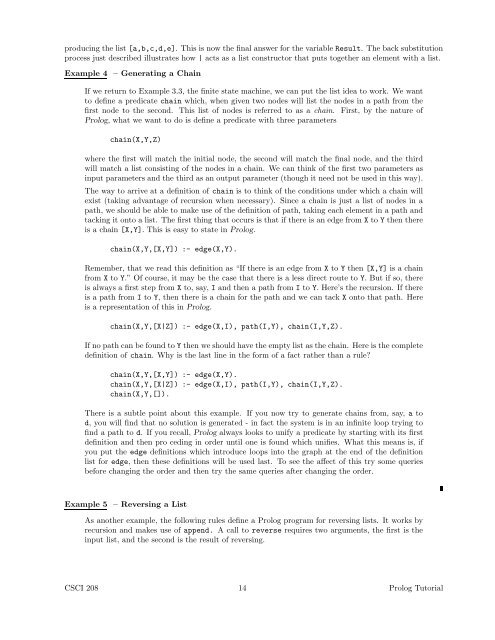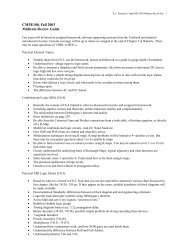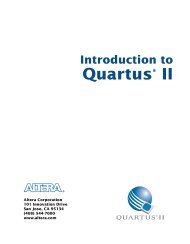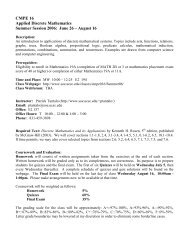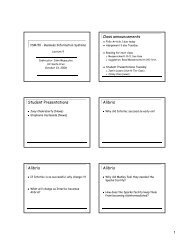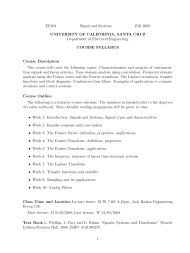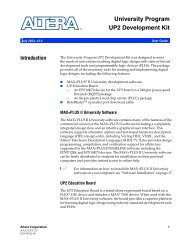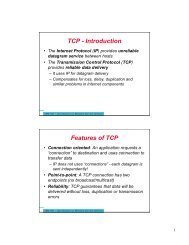Prolog A Tutorial Introduction - Courses
Prolog A Tutorial Introduction - Courses
Prolog A Tutorial Introduction - Courses
You also want an ePaper? Increase the reach of your titles
YUMPU automatically turns print PDFs into web optimized ePapers that Google loves.
producing the list [a,b,c,d,e]. This is now the final answer for the variable Result. The back substitution<br />
process just described illustrates how | acts as a list constructor that puts together an element with a list.<br />
Example 4 – Generating a Chain<br />
If we return to Example 3.3, the finite state machine, we can put the list idea to work. We want<br />
to define a predicate chain which, when given two nodes will list the nodes in a path from the<br />
first node to the second. This list of nodes is referred to as a chain. First, by the nature of<br />
<strong>Prolog</strong>, what we want to do is define a predicate with three parameters<br />
chain(X,Y,Z)<br />
where the first will match the initial node, the second will match the final node, and the third<br />
will match a list consisting of the nodes in a chain. We can think of the first two parameters as<br />
input parameters and the third as an output parameter (though it need not be used in this way).<br />
The way to arrive at a definition of chain is to think of the conditions under which a chain will<br />
exist (taking advantage of recursion when necessary). Since a chain is just a list of nodes in a<br />
path, we should be able to make use of the definition of path, taking each element in a path and<br />
tacking it onto a list. The first thing that occurs is that if there is an edge from X to Y then there<br />
is a chain [X,Y]. This is easy to state in <strong>Prolog</strong>.<br />
chain(X,Y,[X,Y]) :- edge(X,Y).<br />
Remember, that we read this definition as “If there is an edge from X to Y then [X,Y] is a chain<br />
from X to Y.” Of course, it may be the case that there is a less direct route to Y. But if so, there<br />
is always a first step from X to, say, I and then a path from I to Y. Here’s the recursion. If there<br />
is a path from I to Y, then there is a chain for the path and we can tack X onto that path. Here<br />
is a representation of this in <strong>Prolog</strong>.<br />
chain(X,Y,[X|Z]) :- edge(X,I), path(I,Y), chain(I,Y,Z).<br />
If no path can be found to Y then we should have the empty list as the chain. Here is the complete<br />
definition of chain. Why is the last line in the form of a fact rather than a rule?<br />
chain(X,Y,[X,Y]) :- edge(X,Y).<br />
chain(X,Y,[X|Z]) :- edge(X,I), path(I,Y), chain(I,Y,Z).<br />
chain(X,Y,[]).<br />
There is a subtle point about this example. If you now try to generate chains from, say, a to<br />
d, you will find that no solution is generated - in fact the system is in an infinite loop trying to<br />
find a path to d. If you recall, <strong>Prolog</strong> always looks to unify a predicate by starting with its first<br />
definition and then pro ceding in order until one is found which unifies. What this means is, if<br />
you put the edge definitions which introduce loops into the graph at the end of the definition<br />
list for edge, then these definitions will be used last. To see the affect of this try some queries<br />
before changing the order and then try the same queries after changing the order.<br />
Example 5 – Reversing a List<br />
As another example, the following rules define a <strong>Prolog</strong> program for reversing lists. It works by<br />
recursion and makes use of append. Acalltoreverse requires two arguments, the first is the<br />
input list, and the second is the result of reversing.<br />
CSCI 208 14 <strong>Prolog</strong> <strong>Tutorial</strong>


